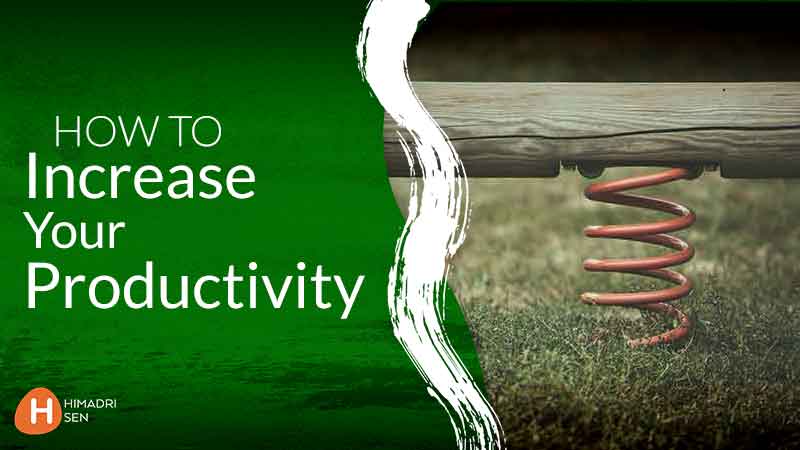Do you want to complete more tasks faster? Everybody wants that! Because of how demanding and busy our lives are.

We need to move through our tasks more quickly to increase productivity. Yikes !!
Table of Contents
It can be incredibly confusing to cross off every item on your to-do list.
But here’s the good news: being productive at work isn’t as hard as it seems. We all want to be more productive, right?
You might already be quite prolific, but there’s always room to increase productivity even more.
Anyone who values results is naturally driven to boost their output.
This drive to produce more is a common trait among those who appreciate achieving their goals.
People often experiment with various techniques to increase productivity.
While some methods work better than others, there are always new tools and strategies that can help you get things done faster.
Your to-do list outlines what you need to accomplish in a single day.

However, sometimes unexpected events can disrupt your focus. When that happens, it’s okay to pause your current task and shift to something else.
This flexibility can actually help increase productivity by keeping you moving forward, even when things don’t go as planned.
Ever wondered how someone might work more effectively?
There’s no magic formula, but certain strategies can significantly increase productivity.
It’s a continuous effort, and each small improvement adds up over time.
Interestingly, productivity is closely linked to happiness.
The more productive you are, the more you’ll feel accomplished and satisfied with your progress.
So, striving to increase productivity not only helps you achieve your goals but also brings a sense of fulfillment and happiness into your life.
What is Productivity?
Let’s first define productivity in order to better grasp the best productivity development strategies discussed in this page.
In economic terms, productivity is a means of measuring the output that results from units of input,
contrary to the traditional definition of productivity, which is “a method of assessing efficiency.”
For a deeper dive into this concept, check out this Investopedia article
It is achieving the desired objectives with less time and effort.
When searching for methods to increase productivity,
what you’re truly seeking is a Technique to accomplish your objectives,
while still having time for important activities with family and friends.
If you’re curious about the broader implications of productivity on a national scale, this McKinsey article
Why Increasing Productivity Important?
– Rising over Competition

The level of productivity we have right now won’t yield any fruitful outcomes in such a competitive market.
If we want to compete successfully and maintain our job and financial freedom, we must concentrate on enhancing productivity.
You gain an advantage by doing anything faster, more effectively, or better than your competitors.
When you Increase productivity it leads to increased growth.
– Improving Wellbeing
One significant advantage of increased productivity is better personal health.
When you’re more productive, you can achieve a state of well-being where you feel healthy, at ease, and content.
By having greater control over your workload, you also gain more control over your life.
This means you can carve out time for essential activities like cooking healthy meals, exercising, and relaxing when you need to.
When you’re less stressed, you can pay greater attention to your body’s demands.
Imagine having access to everything good in life by making a few minor adjustments.
These small changes can combine to produce amazing outcomes, helping you increase productivity and enhance your overall well-being.
– Align Your Professional and Personal Goals

When you increase productivity, your personal and professional goals start to align seamlessly.
This alignment enables you to reach significant milestones while keeping you motivated and happy.
Moreover, involving coworkers who share your interests can further increase productivity.
Collaborating with like-minded individuals fosters a supportive environment that boosts everyone’s efficiency.
So, it’s crucial to identify your top three personal objectives and find ways to integrate them into your work.
To strive for and uphold your established ideals, consider incorporating concepts beyond your current work obligations.
By doing so, you not only increase productivity but also add value to your overall work experience.
– Achieve Goals in the Shortest Time
You should choose the one objective that most closely fits your interests if you want to succeed.
Once you’ve found it, you need to keep looking for it.
Focusing on a single objective at a time is the notion.
It helps you avoid working too hard on too many projects and abandoning them undone.
– Increase Productivity, Improve Confidence
A business invests in the welfare of its workforce when it assists them in being more productive and organized.
The majority of workers see productivity as a business tactic to encourage them to take on more work.
However, increased production results in a win for all parties concerned.
Gaining from greater productivity raises your commitment and morale to your employer and personal objectives.
– Increased Profitability
When it is less expensive to manufacture goods and services, businesses—whether they be individuals or corporations—they are more profitable.
To produce the same number of items, you need less labor as your employees grow more productive.
An organization could decide to keep the same staff and gain from the higher output.
Great Tips for How to Increase Productivity
The main objective for every person and company is to increase productivity.
Higher productivity guarantees better use of available resources and lower production costs.
To advance both personally and professionally, it’s crucial to use productivity enhancement tactics.
Here are some effective strategies to help you increase productivity:
1. Control Your Time
Time management is one of the most important strategies to increase productivity.
You must carefully monitor the time you spend on each work in order to maximize your productivity and achieve your personal and professional objectives.
The most important skill to master success in life and in work is time management.
Look for strategies to avoid spending your time on unnecessary, time-wasting, and pointless activities.
If you’re looking for more detailed tips, this BetterUp article provides nine strategies to regain control over your time.
It covers everything from creating the right environment to setting goals and building good habits.
2. Give Up Perfection
It is extremely typical for people to strive for perfection.
You often take longer than necessary to complete a task because you are pursuing the idea of perfection.
In these situations, do the task at hand and put it out of your mind; you can always return later and make improvements if necessary.
3. Exercise and Meditate

Building strength through exercise improves blood flow throughout the body.
Working under stressful conditions can frequently cause tension and mental instability,
which can cause physical deterioration and unwelcome tiredness.
Don’t skip the chance to exercise whenever you have the chance,
whether it be by going to the gym, taking a stroll, stretching on a yoga mat, or even doing some meditation.
4. Activate Do-Not-Disturb Mode
It can be challenging to resist the temptation to constantly check voicemails, emails, or text messages.
The notifications that pop-up each and every time of all social media subscriptions and apps
are actually not helping you, to get your most important things done.
Therefore, to maintain your concentration and convergence on the topic at hand while working,
switch off the notifications on your phone and Activate the DnD mode.
5. Proactive and Not Reactive
Set your own goals before letting other factors control your work.
Create productivity enhancement methods that suit your abilities, and start each day with a clear work plan.
By keeping timely reminders of your objectives, you can stay motivated throughout the day.
It’s better to act on your own terms rather than being acted upon.
By keeping a timely reminder of your objectives, you can effectively increase productivity and keep yourself going throughout the day.
Acting yourself is preferred over being Acted upon.
For a deeper understanding of how to adopt a proactive mindset, check out this LifeHack article.
Top 10 Techniques to increase productivity
1. GTD Technique:
The principle behind this Technique, GTD or Getting Things Done is an acronym for “The art of stress-free productivity.”
According to the GTD methodology, a person’s capacity for relaxation directly correlates to their level of productivity.
This system, consisting of the five processes—Capture, Clarify, Organize, Engage, and Review —
can significantly increase productivity both professionally and personally.
What makes the GTD system promising is its simplicity and adaptability.
It provides a basic framework that can be adjusted to meet increasing requirements.
-Capture
Anything that comes to mind, write it down. No size is too little or big!
This is the 1st move, and it requires you to “capture” your tasks, to-do lists, thoughts, and ideas.
Try to carry out this step as soon as a task or thought enters your mind.
The back of a receipt, an app, or a beautiful notebook all work the same.
-Clarify
The next step is to turn the disorganized mess of everything you’ve written down into specific next steps.
Now Clarify your objective and divide it into more manageable tasks that you can start working on right immediately.
-Organize
Once clarified, prioritize and categorize your tasks.
Set deadlines for yourself to ensure you finish your work on time.
This organization helps increase productivity by keeping you focused on what needs to be done.
-Engage
This is where taking the time to clarify and organize your tasks pays off. Now that everything in your system is arranged into logical categories and ready for action, you can dive right in and Get It Done (GTD)
-Review
Regularly reviewing your tasks is crucial to increase productivity.
Spend time each week determining what needs to be done immediately, what should be done next, and how quickly each activity is progressing.
This review process allows you to adjust to changes, refocus your attention, decide on your next steps, and consider your overall workflow.
By incorporating the GTD Technique into your routine, you can effectively increase productivity and achieve your personal and professional goals with less stress.
2. Pomodoro technique

Pomodoro means “tomato” in Italian. Francesco Cirillo created this method for the first time in the 1980s as a simple yet effective time management method designed to increase productivity.
A revised edition of Cirillo’s book on the Pomodoro Technique was published in 2013, further refining this powerful strategy.
Short breaks are included into your everyday work routine as part of this time management method to increase productivity.
The Technique is Simple!
How It Works:
- Work for 25 minutes, then take a five-minute break.
- After two hours of work, including frequent five-minute breaks, take a longer break of around thirty minutes to recharge.
When faced with a large assignment or a sequence of tasks, it can be challenging to start or maintain motivation.
By breaking the task into small periods of work followed by short breaks, the Pomodoro Technique makes the task more manageable.
This method helps train your brain to focus, allowing you to progress despite the abundance of distractions.
When willpower alone isn’t enough, the Pomodoro Technique can help you stay on track and increase productivity.
3. Ivy Lee Technique
Writing down everything you need to do is common for a to-do list. Then you proceed through the list, checking each item off as you go.
The Ivy Lee Technique is a powerful four-step process that enhances the standard to-do list,
making it an excellent strategy to increase productivity.
As the Story Goes, in 1918 One of the wealthiest men of his era, Charles Schwab,
hired productivity expert Mr. Ivy Lee to advise him on how to increase productivity of his staff.
Ivy told Schwab to pay him whatever he thought fit after 90 days when he inquired about the cost.
Ivy was rewarded for his work with a check for $25,000 which is worth about $400,000 today keeping Inflation in mind.
So, what was the worth of Ivy Lee’s method, that he was rewarded such a huge sum of money?
Below is what is now Known as Ivy Lee Technique
-Plan for Tomorrow:
Make plans for tomorrow right now. Plan your day in advance and make a list of the ‘six’ things you must do tomorrow.
-Decreasing Order of Priority:
Once they have been listed, order them from most important on top to least important at the bottom.
-Finish one by One:
Start your day with the first task, and stay completely focused on it until it is accomplished.
This will help you to maintain a laser-like focus on the subject at hand and make completion easier.
-Rinse and Repeat:
To finish the other items on your list, follow the same procedure. Only begin the subsequent task until the previous one has been completed.
Add any jobs that were left undone to the list for the next day.
By using this technique, it is simple to stay focused and avoid distractions as we set out time to complete all of the tasks for the day.
This structured approach helps to increase productivity by maintaining clarity and prioritization in your daily activities.
4. 90-20 Rule Technique
The 90-20 rule is very simple: Focus on a single job for 90 minutes, followed by a 20-minute rest.
According to studies, the brain uses up the majority of its glucose, the energy necessary for normal brain function, every 60 to 90 minutes.
To increase productivity, take a break to replenish your brain’s glucose reserves.
You can have a snack, go for a short walk, or do something less intellectually demanding.
This will get you ready for another 90 minutes of work on your to-do list.
Your mind functions like a machine. Like any machine, if it’s run too long without a chance to cool down, it’ll perform worse.
Researchers are also keen to point out that while the 90-20 rule is effective during the standard 8 to 5 workdays,
most people have their own rhythms, and their highest levels of creative energy may not occur during these hours.
They advise people to identify their own peak times, which may be in the early morning or late at night.
Because of modern flexible work schedules and virtual contributions, the 90-20 rule is even more effective.
Try this out and see if it doesn’t help you increase productivity and creativity.
5. Kaizen philosophy Technique
Kaizen, the Japanese word for improvement,
is a working method from Japan focused on reducing waste and engaging in continuous improvement.
Adopting the Kaizen way of working can increase productivity by fostering innovation and creativity.
Your potential to innovate and become more creative will increase when you adopt the Kaizen way of working. Since this is an ongoing process, commitment is needed.
A method like this results in high production with less waste and high productivity. The technique is straightforward and is as follows:
Standardize – Create a process to accomplish a task
Measure – Quantify the efficiency of the process
Compare – Compare how well the process meets the ends
Innovate – Brainstorm ways to reduce waste and redundancies
Improve– Create a better process based on the learning
Repeat – Start with step one again
By continually iterating through these steps, you will increase productivity and reduce waste,
making you a valuable asset to your organization.
6. Eat the Frog Technique

“Eat a live frog first thing in the morning,” said the legendary Mark Twain, “and nothing worse will happen to you the rest of the day.”
This quote is the foundation of Brian Tracy’s well-known “eat the frog” technique.
In this context, the “frog” is the most important and challenging task on your to-do list.
This method is straightforward in that it starts by completing the “frog,” or the hardest work of the day, FIRST.
Getting the most difficult duty finished first thing in the morning can boost confidence and move you closer to your objectives.
By Using Eat the frog technique, Ordering your chores by difficulty or importance,
ensures you focus on what matters most, helping you increase productivity right from the start.
7. Two-minute rule Technique
David Allen, a popular author and productivity expert, discussed his “two-minute rule” in his book Getting Things Done.
If you have a task that can be finished in two minutes, do it right away rather than reviewing and finishing it later.
Consider routine tasks like making your bed, responding to emails, doing the dishes, etc.
This time-management technique helps prevent procrastination
and allows you to complete more tasks each day, significantly increasing productivity.
But what about larger goals that require more time?
For these, the key is to start by breaking the task into smaller, manageable two-minute assignments.
This way, you can make progress on big projects by consistently working on small parts.
8. Eisenhower Matrix
The Eisenhower Matrix is an easy tool for focusing on what will make you most effective, not just most productive, and taking the long-term effects of your everyday actions into account.
It helps you categorize all of your chores according to urgency and importance.
The Eisenhower Matrix is — Urgent vs. Important
Each of these four quadrants will correspond to a specific activity or bigger project you are working on today:
- DO IT IMMEDIATELY: Urgent & Important tasks/projects
- SCHEDULE IT:
Not Urgent & Important tasks/projects
- DELEGATE IT: Urgent & Unimportant tasks/projects
- DELETE IT: Not Urgent & Unimportant tasks/projects
This structured approach helps you focus on what truly matters
and eliminates distractions, thus helping you increase productivity.
9. Zen to Done
Zen to Done (ZTD) is a fantastic method if you’re looking to increase productivity with a focus on habit optimization and personal growth.
Zen to Done (ZTD) is based on the same principles as Getting Things Done (GTD) With a slight variation.
ZTD prioritizes habit optimization and personal growth over specific activities and projects. Similar to GTD, ZTD organizes all of one’s thoughts into a short list of the most crucial tasks that should be completed each day.
Leo Babauta developed the Zen to Done (ZTD) approach to boost productivity.
It can be viewed as the foundation for the Getting Things Done method.
It focuses on the challenging aspect of productivity, namely creating the routines required to maintain productivity.
Babauta’s Zen to Done approach is designed to boost productivity by establishing one habit at a time, making the process less overwhelming.
By creating habit after habit without making you feel overburdened
by the number of things you might wish to change, Zen to Done aims to make change achievable.
Babauta as a result developed the so-called Minimalist ZTD, which has four fundamental habits at its core.
Before moving on to the next habit, he advises practicing one or two habits for the first 30 days.
The Four major habits can be summed up as follows:
Collect: Write down your ideas and to-dos to clear your mind.
Process: Every day, take a look at your list and decide how you want to handle each duty.
Plan: Prioritize your list, then cross out items as they become less important.
Do: Set aside time to complete each work without being interrupted.
By focusing on these habits, you can significantly increase productivity, ensuring that you stay organized and efficient.
This approach not only helps you manage your tasks but also fosters personal growth by instilling productive habits that last.
Give Zen to Done a try
10. SMART Goals
SMART Goals actually helps you to get the Bigger Picture.
Many people spend their entire life hopping around from one job to another or frantically attempting to do more while actually getting very little done.
By creating SMART goals, you can improve your chances of reaching your life’s goals by streamlining your thoughts,
concentrating your efforts, and making efficient use of your time and resources to incease productivity.
You may focus on getting what you desire by using this framework to develop goals.
A SMART goal is one that is Specific, Measurable, Assignable, Realistic, and Time-bound.
I will expand the abbreviations to explore how to create, develop and achieve your goals:
1. Specific
Your goal should be clear and specific. Try to answer the following five “W” questions when creating your goal:
- What do I want to achieve?
- Why is this goal so essential?
- Who is concerned?
- Where is it located?
- Which limitations or resources are involved?
2. Measurable
It’s important to establish measurable Goals so you can monitor your progress and maintain motivation.
A measurable goal should answer issues like:
- How much?
- How many?
- How will I know when it is finished?
3. Achievable
To be effective, your goal must also be attainable and reasonable. It should therefore be challenging for you while still being doable.
An answer to a question like below, should be an achievable goal
- How can I achieve this objective?
- How feasible is the goal, based on my financial limitations?
4. Realistic
This step involves making sure that your goal matters to you and that it is relevant with the other key targets.
For a relevant goal, one can answer “yes” to these questions:
- Do you think this is worthwhile?
- Is it appropriate now?
- Does this fit with our other needs or efforts?
- Am I the best person to accomplish this task?
5. Time-bound
Every Goal needs a target date so you have something to aim toward and a deadline to concentrate on.
A time-bound goal will usually answer the following questions:
- When?
- What can I do six months from now?
- What can I do six weeks from now?
- What can I do today?
Let us take up a Health-related goal for an example so it can be easily understandable to anyone here, who is reading this.
SMART GOAL EXAMPLE:
“For the next eight weeks, I will reduce one pound each week. I will achieve this by restricting my daily calorie intake to 1,200 and walking for 30 minutes five days a week”
Why this is a SMART Goal? Let us investigate below:
Specific: Both weekly and daily goals are present, making this goal Specific.
Measurable: Three aspects of this goal – minutes, days and calories are Measurable.
Attainable: Setting incremental progress makes this goal is definitely Attainable.
Realistic: One pound per week weight loss is a Realistic goal that won’t overwhelm you.
Time Bound: Next 8 Weeks gives hope that you will hit your goal within that Time Frame.
For a detailed guide on how to set SMART goals, check out this MindTools article.
It provides a comprehensive breakdown of each component and offers practical examples to help you create your own SMART goals.
FAQ’s
Wrapping Up
The secret towards achieving personal business success and result-driven goals may be hidden within YOU.
Your productivity Management can help your life and business greatly when done correctly.
However, to increase productivity requires work on your side, just like any other improvement in your life.
A new habit can take up to three months to form, whether it’s creating a daily to-do list to organize your day or starting a regular exercise schedule.
Once something has developed a habit, incorporating it into a routine is considerably simpler.
I wish you all the best, towards your developing NEW YOU.
Please care to share this article by clicking the below Links so that it reaches to your friends.
–9 amazing Work-Life Balance Tricks for women
–10 Tools and Methods for improving Productivity and Soar
–7 ways Emotional Intelligence (EQ) can Increase Productivity